A painter is a rope that is attached to the bow of a dinghy, or other small boat, and used for tying up or towing. [1] Ideally, the painter should float. If used on a boat with a propeller, the length of the painter should be shorter than the distance to the propeller, to prevent fouling the engine. [2]
Canoes being used in moving water or whitewater are rigged with a painter at both the bow and stern. [3] In addition to the functions mentioned above, a canoe's painters can be used for lining the boat down difficult sections, [4] self-rescue, [5] and boat recovery. [6]

A propeller is a device with a rotating hub and radiating blades that are set at a pitch to form a helical spiral which, when rotated, exerts linear thrust upon a working fluid such as water or air. Propellers are used to pump fluid through a pipe or duct, or to create thrust to propel a boat through water or an aircraft through air. The blades are shaped so that their rotational motion through the fluid causes a pressure difference between the two surfaces of the blade by Bernoulli's principle which exerts force on the fluid. Most marine propellers are screw propellers with helical blades rotating on a propeller shaft with an approximately horizontal axis.
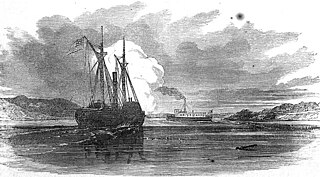
A tugboat or tug is a marine vessel that manoeuvres other vessels by pushing or pulling them, with direct contact or a tow line. These boats typically tug ships in circumstances where they cannot or should not move under their own power, such as in crowded harbors or narrow canals, or cannot move at all, such as barges, disabled ships, log rafts, or oil platforms. Some are ocean-going, and some are icebreakers or salvage tugs. Early models were powered by steam engines, which were later superseded by diesel engines. Many have deluge gun water jets, which help in firefighting, especially in harbours.

PT-109 was an 80' Elco PT boat last commanded by Lieutenant John F. Kennedy, future United States president, in the Solomon Islands campaign of the Pacific theater during World War II. Kennedy's actions in saving his surviving crew after PT-109 was rammed and sunk by a Japanese destroyer earned him several commendations and made him a war hero. Back problems stemming from the incident required months of hospitalization at Chelsea Naval Hospital and plagued him the rest of his life. Kennedy's postwar campaigns for elected office referred often to his service on PT-109.
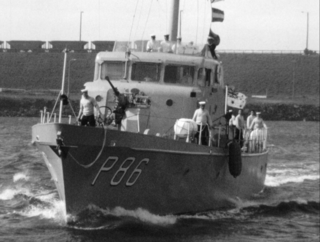
HMAS Archer was an Attack-class patrol boat of the Royal Australian Navy (RAN).

HMAS Assail was an Attack-class patrol boat of the Royal Australian Navy (RAN).
HMAS Bandolier was an Attack-class patrol boat of the Royal Australian Navy (RAN).
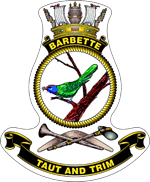
HMAS Barbette was an Attack-class patrol boat of the Royal Australian Navy (RAN).
HMAS Bombard was an Attack-class patrol boat of the Royal Australian Navy (RAN).

HMS A11 was an A-class submarine built for the Royal Navy in the first decade of the 20th century. After surviving World War I, she was sold for scrap in 1920.
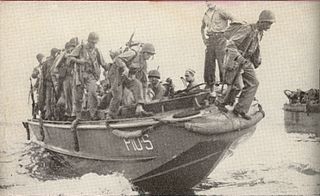
The Landing Craft Personnel (Large) or LCP (L) was a landing craft used extensively in the Second World War. Its primary purpose was to ferry troops from transport ships to attack enemy-held shores. The craft derived from a prototype designed by the Eureka Tug-Boat Company of New Orleans, Louisiana, USA. Manufactured initially in boatyards in and around New Orleans, as requirements grew it was produced in a number of yards around the United States. Typically constructed of pine planks and plywood, and fitted with some armor plate, this shallow-draft boat with a crew of 3, could ferry an infantry platoon of 36 to shore at 8 knots (13 km/h). Men generally entered the boat by walking over a gangplank from the boat deck of their troop transport as the LCP(L) hung from its davits. When loaded, the LCP(L) was lowered into the water. Soldiers exited the boat by jumping or climbing down from the craft's bow or sides.

The German submarine U-8 was a Type IIB U-boat of Nazi Germany's Kriegsmarine, based at Kiel during World War II. It was one of the smaller versions, and was first launched on 16 July 1935. Its first commander was Harald Grosse. U-8 would have 18 commanders over the course of its service, the last being Jürgen Kriegshammer.

HMS L4 was a L-class submarine built for the Royal Navy during World War I. The boat survived the war and was sold for scrap in 1934.

HMS L5 was a L-class submarine built for the Royal Navy during World War I. The boat survived the war and was sold for scrap in 1931.
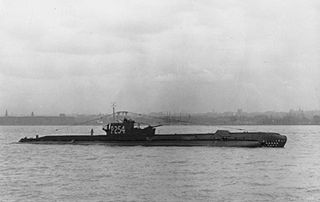
HMS Selene was a S-class submarine of the third batch built for the Royal Navy during World War II. She survived the war and was sold for scrap in 1961.
SM U-40 was a German Type U 31 U-boat of the German Imperial Navy during World War I.
German submarine U-76 was a Type VIIB U-boat of Nazi Germany's Kriegsmarine during World War II. She played a minor role in the Battle of the Atlantic, but was destroyed south of Iceland.

German submarine U-55 was a Type VIIB U-boat of Nazi Germany's Kriegsmarine during World War II. She was ordered on 16 July 1937 and laid down on 2 November 1938 at Friedrich Krupp Germaniawerft in Kiel as yard number 590. Launched on 19 October 1939, she went into service on 21 November 1939 under the command of Kapitänleutnant (Kptlt.) Werner Heidel.
German submarine U-536 was a Type IXC U-boat of Nazi Germany's Kriegsmarine during World War II.
German submarine U-574 was a Type VIIC U-boat of Nazi Germany's Kriegsmarine during World War II. She carried out one war patrol and sank one warship of 1,190 tons. The U-boat was sunk west of Portugal on 19 December 1941.
German submarine U-598 was a Type VIIC U-boat of Nazi Germany's Kriegsmarine during World War II.